Leadership and Management Approaches in Tesco's Operational Context
VerifiedAdded on 2024/05/30
|19
|4065
|458
Report
AI Summary
This report provides a comprehensive analysis of management and leadership roles within Tesco's operational context. It begins by defining and comparing the roles and characteristics of managers and leaders, followed by examining how these roles apply in various situations. The report then applies different leadership theories and models, including situational leadership, system leadership, and contingency theory, to Tesco's operations. Furthermore, it explains key approaches to operations management, such as Six Sigma and Total Quality Management, and the role managers and leaders play in their implementation. The report also assesses the impact of the business environment on operational management and decision-making processes, highlighting the importance of effective leadership and management in achieving business objectives. This student contributed the assignment to Desklib, a platform providing study tools for students.
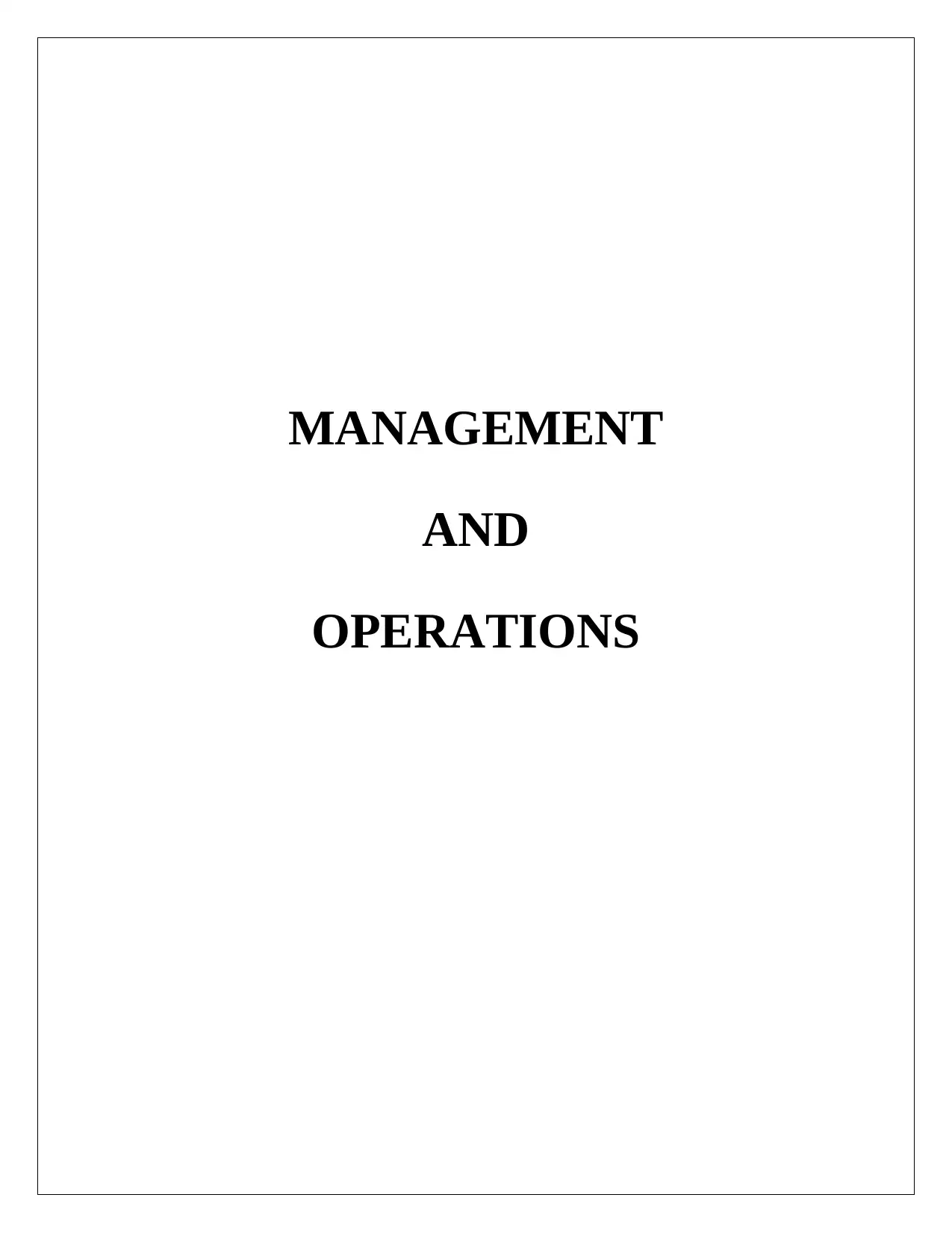
MANAGEMENT
AND
OPERATIONS
AND
OPERATIONS
Paraphrase This Document
Need a fresh take? Get an instant paraphrase of this document with our AI Paraphraser
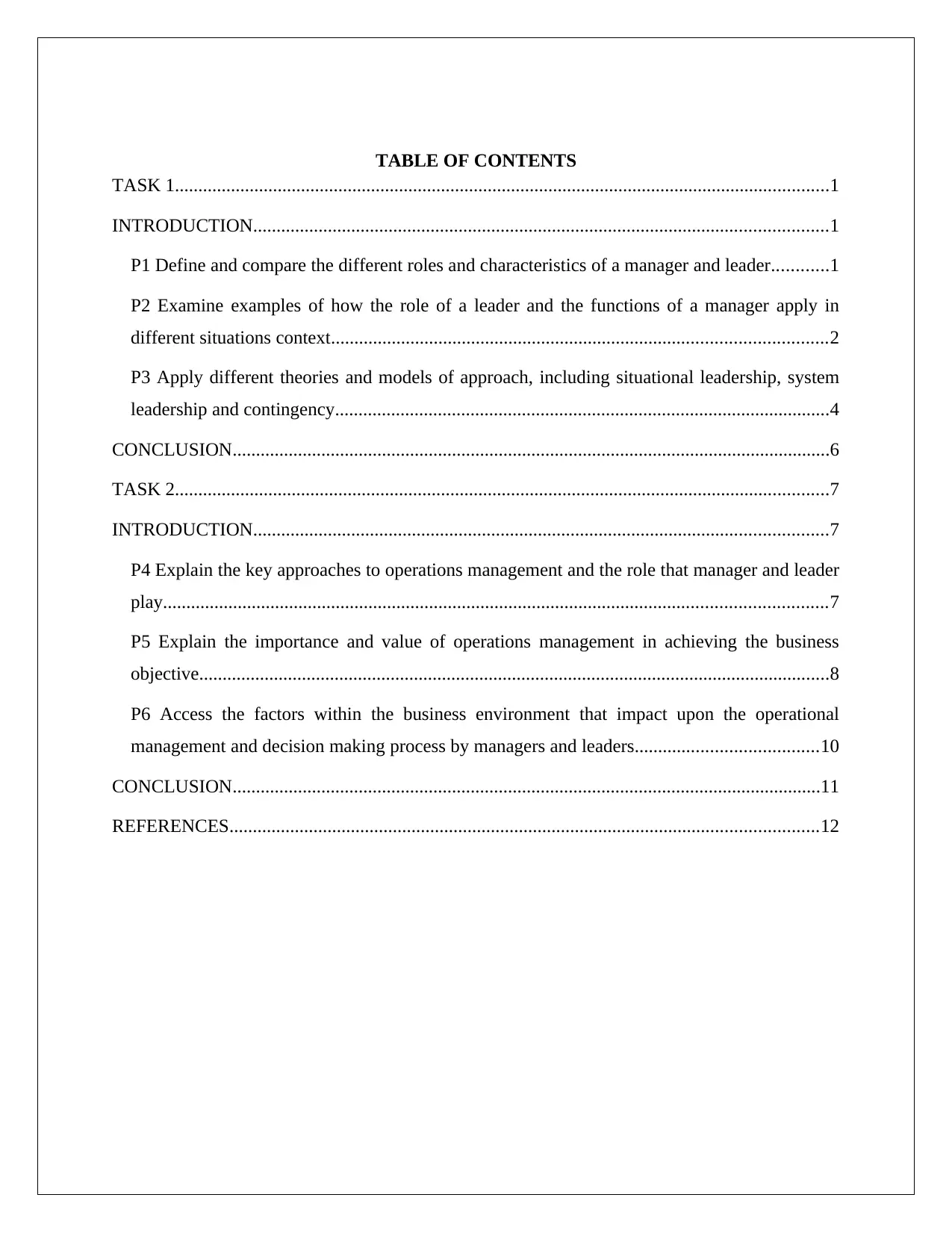
TABLE OF CONTENTS
TASK 1............................................................................................................................................1
INTRODUCTION...........................................................................................................................1
P1 Define and compare the different roles and characteristics of a manager and leader............1
P2 Examine examples of how the role of a leader and the functions of a manager apply in
different situations context..........................................................................................................2
P3 Apply different theories and models of approach, including situational leadership, system
leadership and contingency..........................................................................................................4
CONCLUSION................................................................................................................................6
TASK 2............................................................................................................................................7
INTRODUCTION...........................................................................................................................7
P4 Explain the key approaches to operations management and the role that manager and leader
play..............................................................................................................................................7
P5 Explain the importance and value of operations management in achieving the business
objective.......................................................................................................................................8
P6 Access the factors within the business environment that impact upon the operational
management and decision making process by managers and leaders.......................................10
CONCLUSION..............................................................................................................................11
REFERENCES..............................................................................................................................12
TASK 1............................................................................................................................................1
INTRODUCTION...........................................................................................................................1
P1 Define and compare the different roles and characteristics of a manager and leader............1
P2 Examine examples of how the role of a leader and the functions of a manager apply in
different situations context..........................................................................................................2
P3 Apply different theories and models of approach, including situational leadership, system
leadership and contingency..........................................................................................................4
CONCLUSION................................................................................................................................6
TASK 2............................................................................................................................................7
INTRODUCTION...........................................................................................................................7
P4 Explain the key approaches to operations management and the role that manager and leader
play..............................................................................................................................................7
P5 Explain the importance and value of operations management in achieving the business
objective.......................................................................................................................................8
P6 Access the factors within the business environment that impact upon the operational
management and decision making process by managers and leaders.......................................10
CONCLUSION..............................................................................................................................11
REFERENCES..............................................................................................................................12
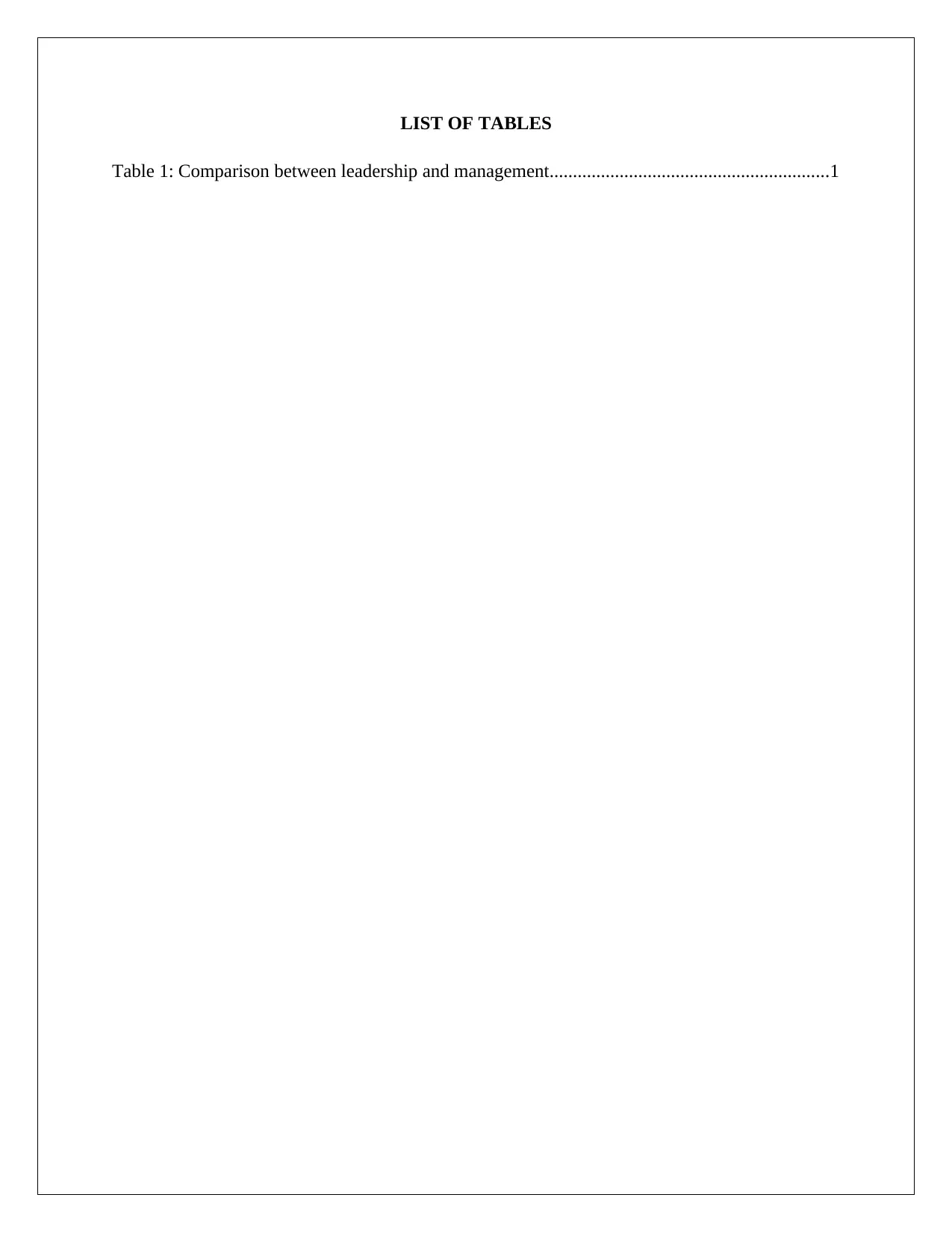
LIST OF TABLES
Table 1: Comparison between leadership and management............................................................1
Table 1: Comparison between leadership and management............................................................1
⊘ This is a preview!⊘
Do you want full access?
Subscribe today to unlock all pages.

Trusted by 1+ million students worldwide
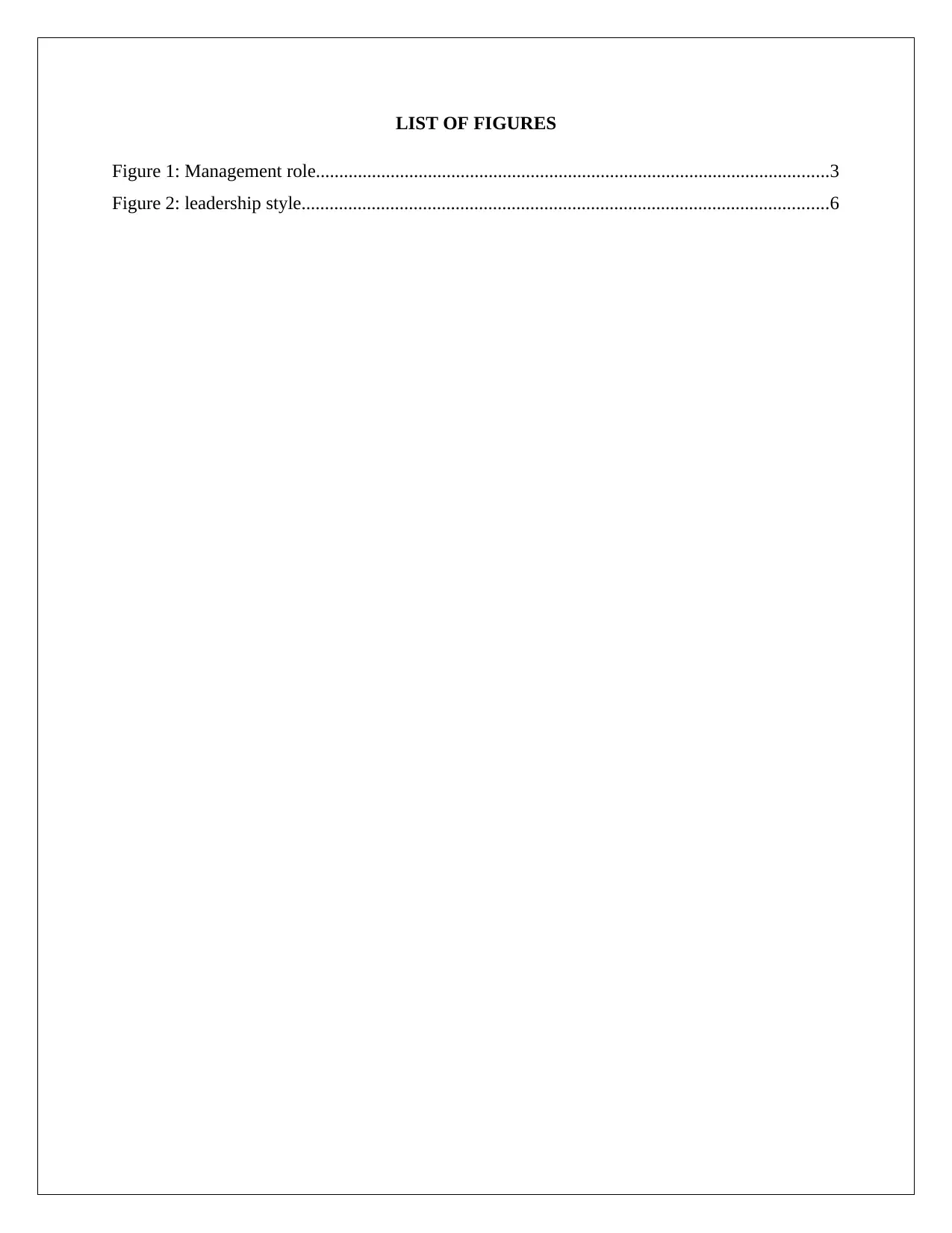
LIST OF FIGURES
Figure 1: Management role..............................................................................................................3
Figure 2: leadership style.................................................................................................................6
Figure 1: Management role..............................................................................................................3
Figure 2: leadership style.................................................................................................................6
Paraphrase This Document
Need a fresh take? Get an instant paraphrase of this document with our AI Paraphraser
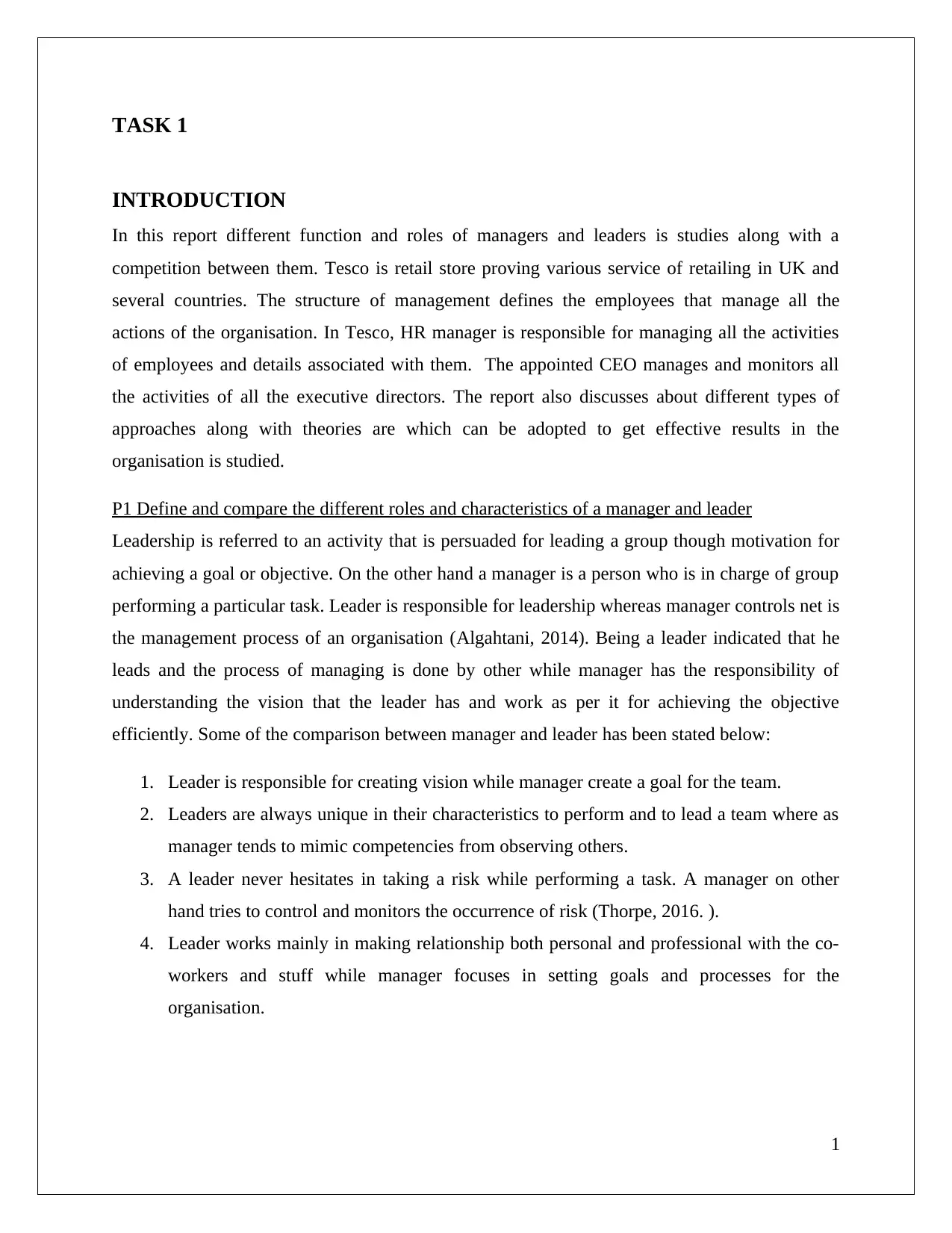
TASK 1
INTRODUCTION
In this report different function and roles of managers and leaders is studies along with a
competition between them. Tesco is retail store proving various service of retailing in UK and
several countries. The structure of management defines the employees that manage all the
actions of the organisation. In Tesco, HR manager is responsible for managing all the activities
of employees and details associated with them. The appointed CEO manages and monitors all
the activities of all the executive directors. The report also discusses about different types of
approaches along with theories are which can be adopted to get effective results in the
organisation is studied.
P1 Define and compare the different roles and characteristics of a manager and leader
Leadership is referred to an activity that is persuaded for leading a group though motivation for
achieving a goal or objective. On the other hand a manager is a person who is in charge of group
performing a particular task. Leader is responsible for leadership whereas manager controls net is
the management process of an organisation (Algahtani, 2014). Being a leader indicated that he
leads and the process of managing is done by other while manager has the responsibility of
understanding the vision that the leader has and work as per it for achieving the objective
efficiently. Some of the comparison between manager and leader has been stated below:
1. Leader is responsible for creating vision while manager create a goal for the team.
2. Leaders are always unique in their characteristics to perform and to lead a team where as
manager tends to mimic competencies from observing others.
3. A leader never hesitates in taking a risk while performing a task. A manager on other
hand tries to control and monitors the occurrence of risk (Thorpe, 2016. ).
4. Leader works mainly in making relationship both personal and professional with the co-
workers and stuff while manager focuses in setting goals and processes for the
organisation.
1
INTRODUCTION
In this report different function and roles of managers and leaders is studies along with a
competition between them. Tesco is retail store proving various service of retailing in UK and
several countries. The structure of management defines the employees that manage all the
actions of the organisation. In Tesco, HR manager is responsible for managing all the activities
of employees and details associated with them. The appointed CEO manages and monitors all
the activities of all the executive directors. The report also discusses about different types of
approaches along with theories are which can be adopted to get effective results in the
organisation is studied.
P1 Define and compare the different roles and characteristics of a manager and leader
Leadership is referred to an activity that is persuaded for leading a group though motivation for
achieving a goal or objective. On the other hand a manager is a person who is in charge of group
performing a particular task. Leader is responsible for leadership whereas manager controls net is
the management process of an organisation (Algahtani, 2014). Being a leader indicated that he
leads and the process of managing is done by other while manager has the responsibility of
understanding the vision that the leader has and work as per it for achieving the objective
efficiently. Some of the comparison between manager and leader has been stated below:
1. Leader is responsible for creating vision while manager create a goal for the team.
2. Leaders are always unique in their characteristics to perform and to lead a team where as
manager tends to mimic competencies from observing others.
3. A leader never hesitates in taking a risk while performing a task. A manager on other
hand tries to control and monitors the occurrence of risk (Thorpe, 2016. ).
4. Leader works mainly in making relationship both personal and professional with the co-
workers and stuff while manager focuses in setting goals and processes for the
organisation.
1
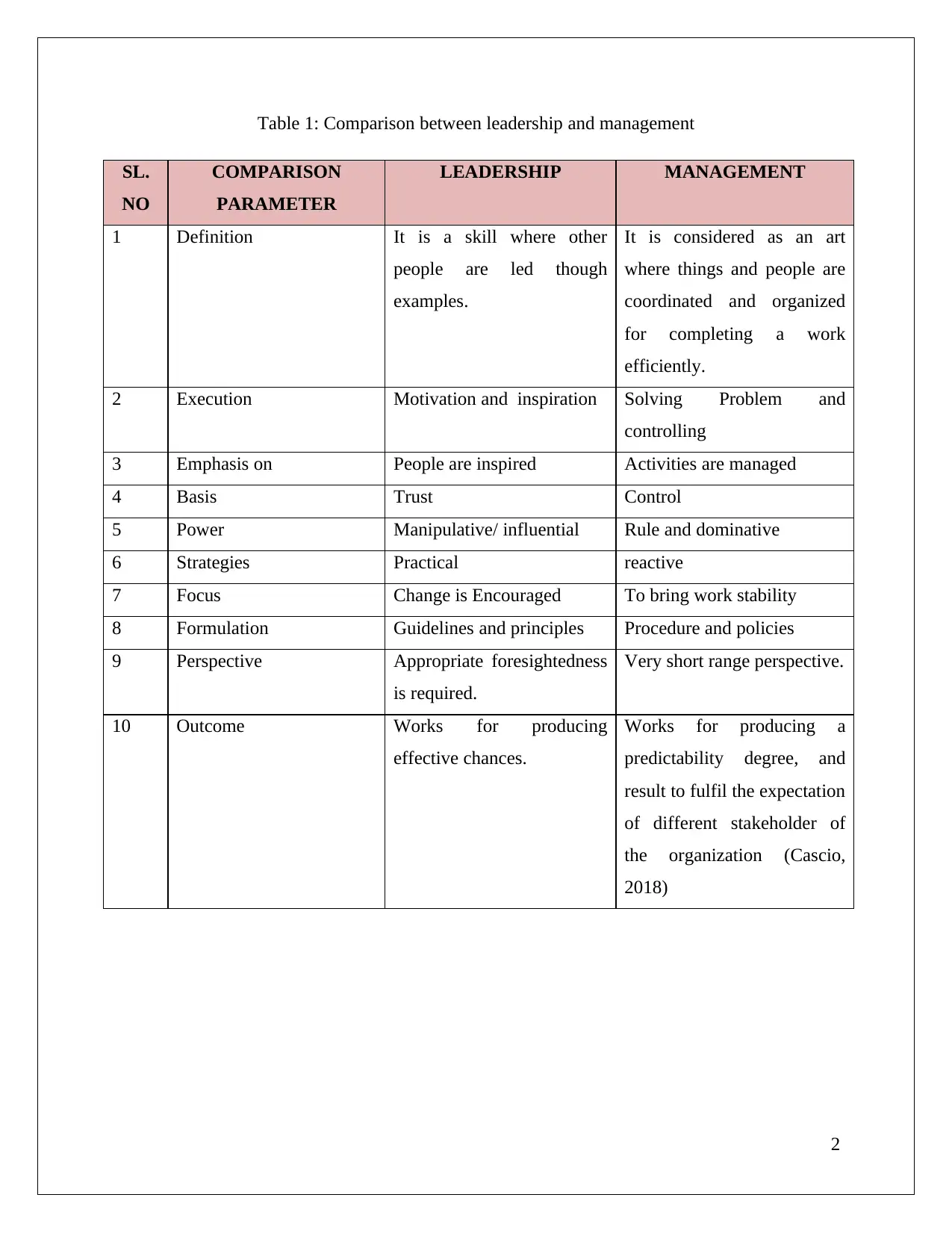
Table 1: Comparison between leadership and management
SL.
NO
COMPARISON
PARAMETER
LEADERSHIP MANAGEMENT
1 Definition It is a skill where other
people are led though
examples.
It is considered as an art
where things and people are
coordinated and organized
for completing a work
efficiently.
2 Execution Motivation and inspiration Solving Problem and
controlling
3 Emphasis on People are inspired Activities are managed
4 Basis Trust Control
5 Power Manipulative/ influential Rule and dominative
6 Strategies Practical reactive
7 Focus Change is Encouraged To bring work stability
8 Formulation Guidelines and principles Procedure and policies
9 Perspective Appropriate foresightedness
is required.
Very short range perspective.
10 Outcome Works for producing
effective chances.
Works for producing a
predictability degree, and
result to fulfil the expectation
of different stakeholder of
the organization (Cascio,
2018)
2
SL.
NO
COMPARISON
PARAMETER
LEADERSHIP MANAGEMENT
1 Definition It is a skill where other
people are led though
examples.
It is considered as an art
where things and people are
coordinated and organized
for completing a work
efficiently.
2 Execution Motivation and inspiration Solving Problem and
controlling
3 Emphasis on People are inspired Activities are managed
4 Basis Trust Control
5 Power Manipulative/ influential Rule and dominative
6 Strategies Practical reactive
7 Focus Change is Encouraged To bring work stability
8 Formulation Guidelines and principles Procedure and policies
9 Perspective Appropriate foresightedness
is required.
Very short range perspective.
10 Outcome Works for producing
effective chances.
Works for producing a
predictability degree, and
result to fulfil the expectation
of different stakeholder of
the organization (Cascio,
2018)
2
⊘ This is a preview!⊘
Do you want full access?
Subscribe today to unlock all pages.

Trusted by 1+ million students worldwide
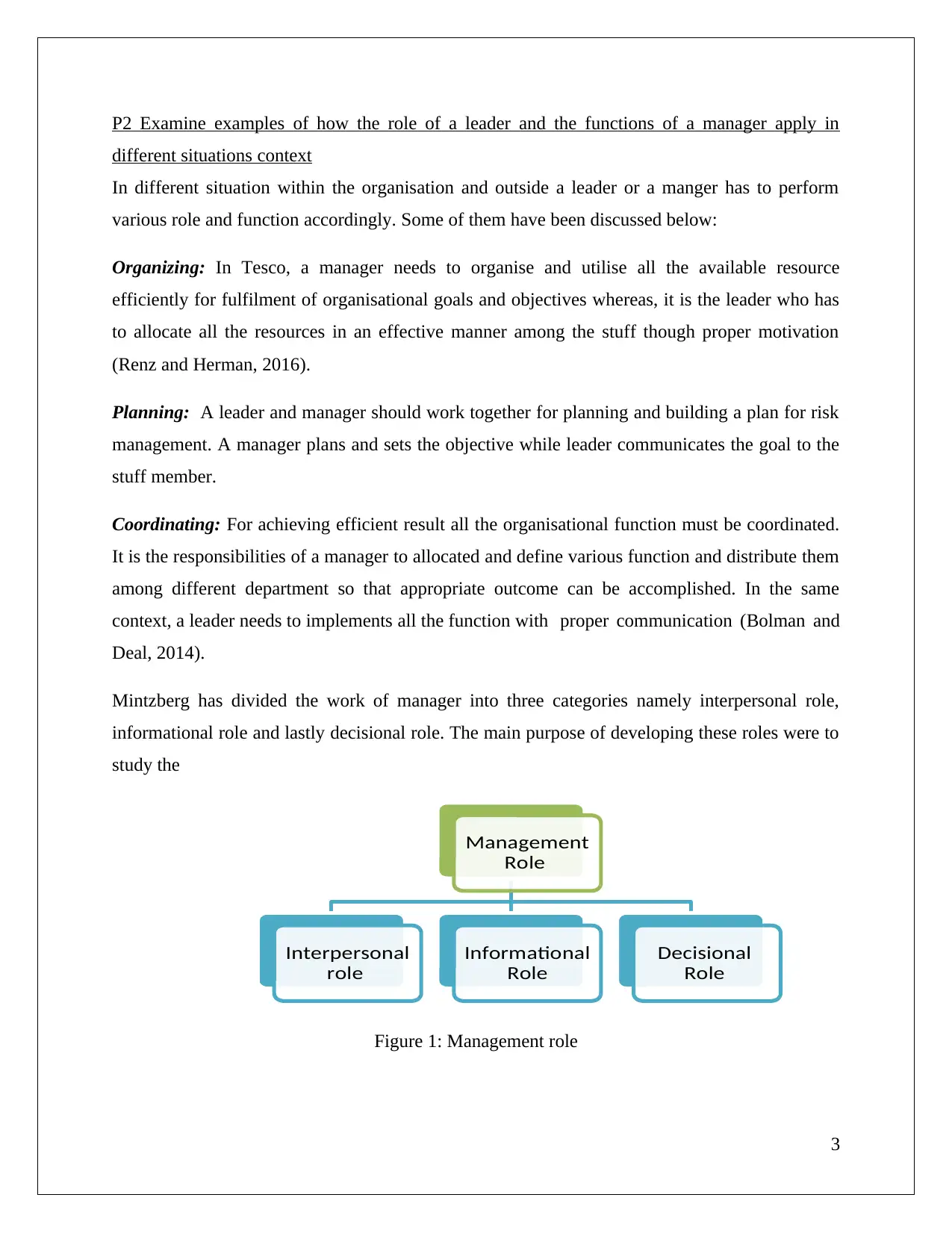
P2 Examine examples of how the role of a leader and the functions of a manager apply in
different situations context
In different situation within the organisation and outside a leader or a manger has to perform
various role and function accordingly. Some of them have been discussed below:
Organizing: In Tesco, a manager needs to organise and utilise all the available resource
efficiently for fulfilment of organisational goals and objectives whereas, it is the leader who has
to allocate all the resources in an effective manner among the stuff though proper motivation
(Renz and Herman, 2016).
Planning: A leader and manager should work together for planning and building a plan for risk
management. A manager plans and sets the objective while leader communicates the goal to the
stuff member.
Coordinating: For achieving efficient result all the organisational function must be coordinated.
It is the responsibilities of a manager to allocated and define various function and distribute them
among different department so that appropriate outcome can be accomplished. In the same
context, a leader needs to implements all the function with proper communication (Bolman and
Deal, 2014).
Mintzberg has divided the work of manager into three categories namely interpersonal role,
informational role and lastly decisional role. The main purpose of developing these roles were to
study the
Figure 1: Management role
3
Management
Role
Interpersonal
role
Informational
Role
Decisional
Role
different situations context
In different situation within the organisation and outside a leader or a manger has to perform
various role and function accordingly. Some of them have been discussed below:
Organizing: In Tesco, a manager needs to organise and utilise all the available resource
efficiently for fulfilment of organisational goals and objectives whereas, it is the leader who has
to allocate all the resources in an effective manner among the stuff though proper motivation
(Renz and Herman, 2016).
Planning: A leader and manager should work together for planning and building a plan for risk
management. A manager plans and sets the objective while leader communicates the goal to the
stuff member.
Coordinating: For achieving efficient result all the organisational function must be coordinated.
It is the responsibilities of a manager to allocated and define various function and distribute them
among different department so that appropriate outcome can be accomplished. In the same
context, a leader needs to implements all the function with proper communication (Bolman and
Deal, 2014).
Mintzberg has divided the work of manager into three categories namely interpersonal role,
informational role and lastly decisional role. The main purpose of developing these roles were to
study the
Figure 1: Management role
3
Management
Role
Interpersonal
role
Informational
Role
Decisional
Role
Paraphrase This Document
Need a fresh take? Get an instant paraphrase of this document with our AI Paraphraser
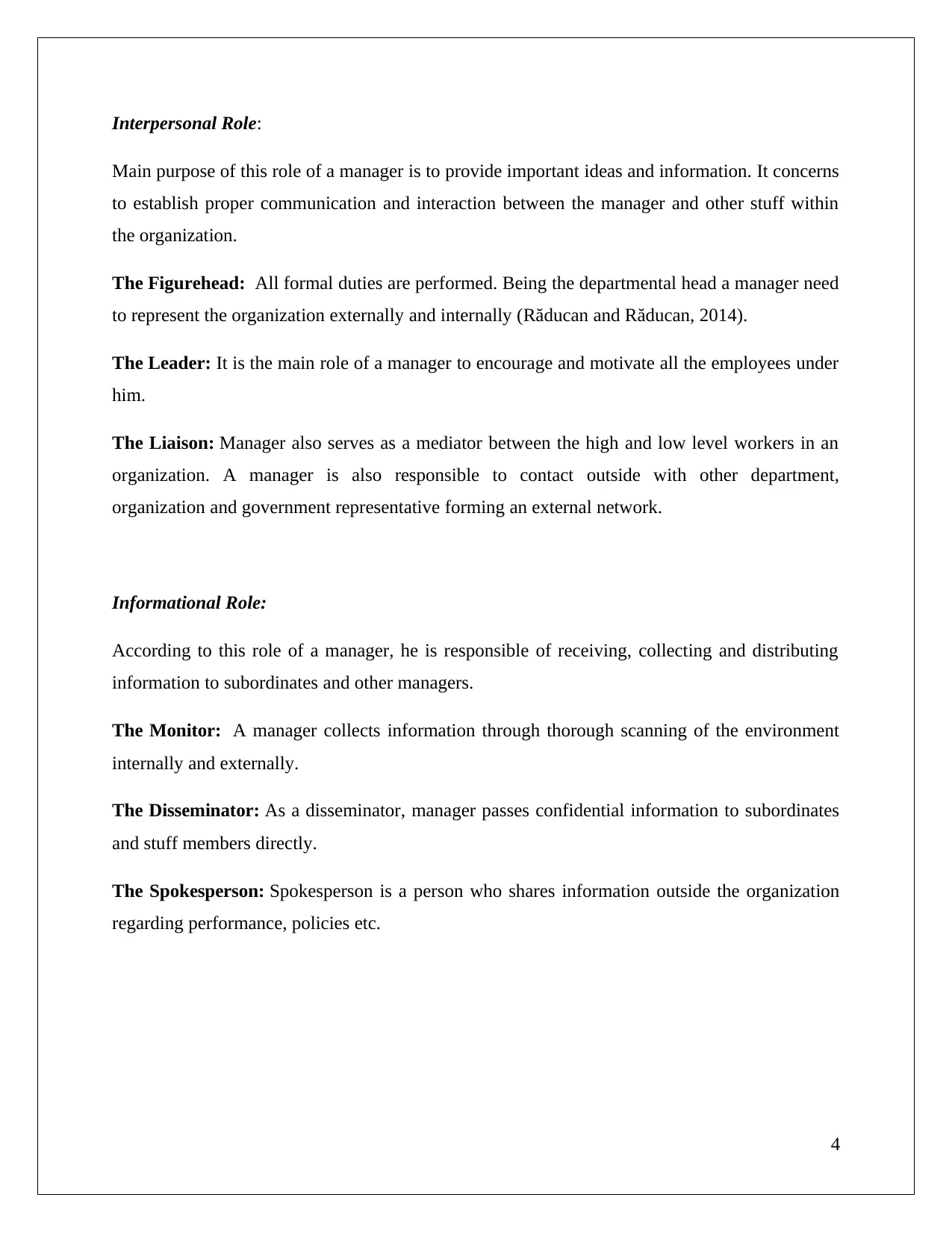
Interpersonal Role:
Main purpose of this role of a manager is to provide important ideas and information. It concerns
to establish proper communication and interaction between the manager and other stuff within
the organization.
The Figurehead: All formal duties are performed. Being the departmental head a manager need
to represent the organization externally and internally (Răducan and Răducan, 2014).
The Leader: It is the main role of a manager to encourage and motivate all the employees under
him.
The Liaison: Manager also serves as a mediator between the high and low level workers in an
organization. A manager is also responsible to contact outside with other department,
organization and government representative forming an external network.
Informational Role:
According to this role of a manager, he is responsible of receiving, collecting and distributing
information to subordinates and other managers.
The Monitor: A manager collects information through thorough scanning of the environment
internally and externally.
The Disseminator: As a disseminator, manager passes confidential information to subordinates
and stuff members directly.
The Spokesperson: Spokesperson is a person who shares information outside the organization
regarding performance, policies etc.
4
Main purpose of this role of a manager is to provide important ideas and information. It concerns
to establish proper communication and interaction between the manager and other stuff within
the organization.
The Figurehead: All formal duties are performed. Being the departmental head a manager need
to represent the organization externally and internally (Răducan and Răducan, 2014).
The Leader: It is the main role of a manager to encourage and motivate all the employees under
him.
The Liaison: Manager also serves as a mediator between the high and low level workers in an
organization. A manager is also responsible to contact outside with other department,
organization and government representative forming an external network.
Informational Role:
According to this role of a manager, he is responsible of receiving, collecting and distributing
information to subordinates and other managers.
The Monitor: A manager collects information through thorough scanning of the environment
internally and externally.
The Disseminator: As a disseminator, manager passes confidential information to subordinates
and stuff members directly.
The Spokesperson: Spokesperson is a person who shares information outside the organization
regarding performance, policies etc.
4
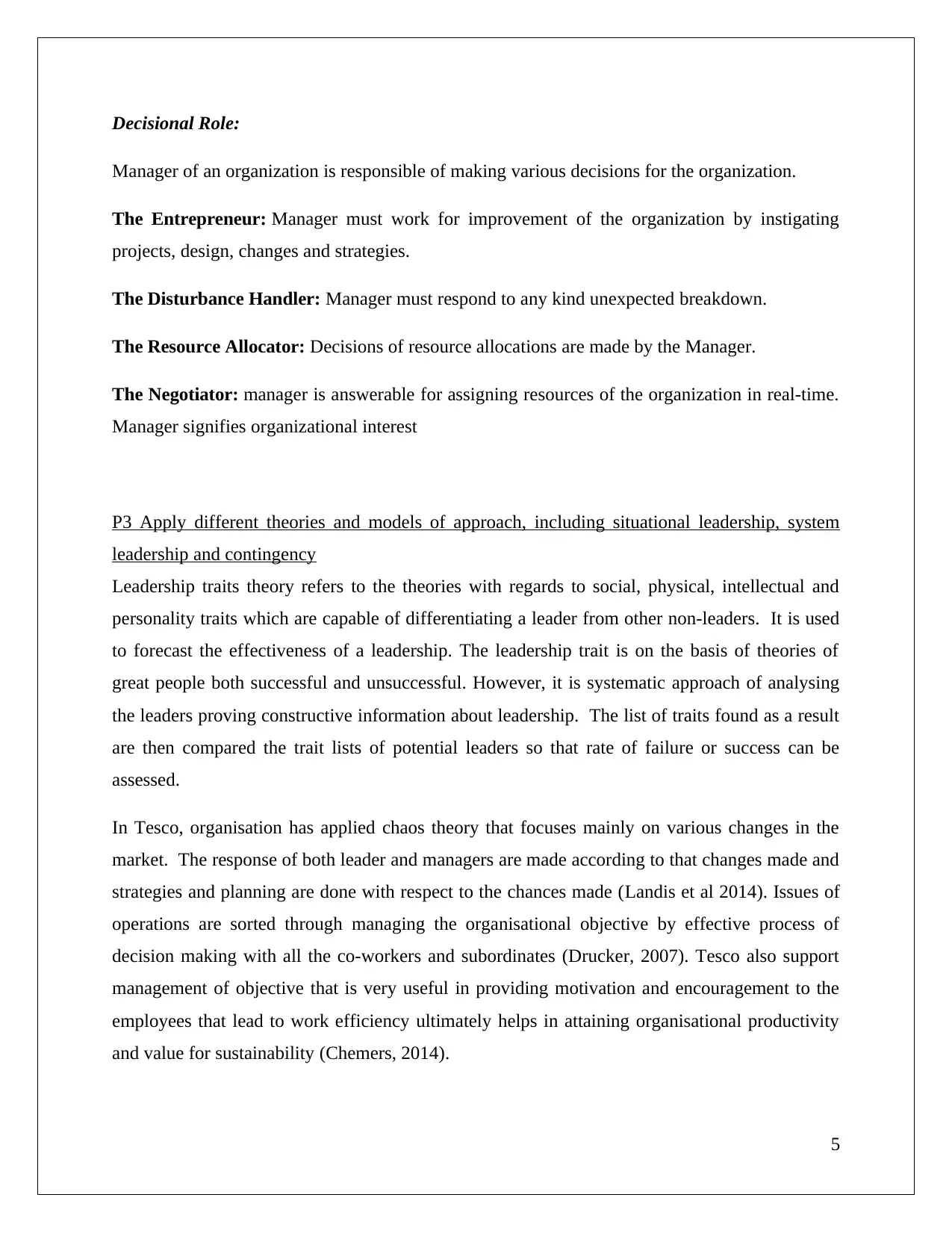
Decisional Role:
Manager of an organization is responsible of making various decisions for the organization.
The Entrepreneur: Manager must work for improvement of the organization by instigating
projects, design, changes and strategies.
The Disturbance Handler: Manager must respond to any kind unexpected breakdown.
The Resource Allocator: Decisions of resource allocations are made by the Manager.
The Negotiator: manager is answerable for assigning resources of the organization in real-time.
Manager signifies organizational interest
P3 Apply different theories and models of approach, including situational leadership, system
leadership and contingency
Leadership traits theory refers to the theories with regards to social, physical, intellectual and
personality traits which are capable of differentiating a leader from other non-leaders. It is used
to forecast the effectiveness of a leadership. The leadership trait is on the basis of theories of
great people both successful and unsuccessful. However, it is systematic approach of analysing
the leaders proving constructive information about leadership. The list of traits found as a result
are then compared the trait lists of potential leaders so that rate of failure or success can be
assessed.
In Tesco, organisation has applied chaos theory that focuses mainly on various changes in the
market. The response of both leader and managers are made according to that changes made and
strategies and planning are done with respect to the chances made (Landis et al 2014). Issues of
operations are sorted through managing the organisational objective by effective process of
decision making with all the co-workers and subordinates (Drucker, 2007). Tesco also support
management of objective that is very useful in providing motivation and encouragement to the
employees that lead to work efficiency ultimately helps in attaining organisational productivity
and value for sustainability (Chemers, 2014).
5
Manager of an organization is responsible of making various decisions for the organization.
The Entrepreneur: Manager must work for improvement of the organization by instigating
projects, design, changes and strategies.
The Disturbance Handler: Manager must respond to any kind unexpected breakdown.
The Resource Allocator: Decisions of resource allocations are made by the Manager.
The Negotiator: manager is answerable for assigning resources of the organization in real-time.
Manager signifies organizational interest
P3 Apply different theories and models of approach, including situational leadership, system
leadership and contingency
Leadership traits theory refers to the theories with regards to social, physical, intellectual and
personality traits which are capable of differentiating a leader from other non-leaders. It is used
to forecast the effectiveness of a leadership. The leadership trait is on the basis of theories of
great people both successful and unsuccessful. However, it is systematic approach of analysing
the leaders proving constructive information about leadership. The list of traits found as a result
are then compared the trait lists of potential leaders so that rate of failure or success can be
assessed.
In Tesco, organisation has applied chaos theory that focuses mainly on various changes in the
market. The response of both leader and managers are made according to that changes made and
strategies and planning are done with respect to the chances made (Landis et al 2014). Issues of
operations are sorted through managing the organisational objective by effective process of
decision making with all the co-workers and subordinates (Drucker, 2007). Tesco also support
management of objective that is very useful in providing motivation and encouragement to the
employees that lead to work efficiency ultimately helps in attaining organisational productivity
and value for sustainability (Chemers, 2014).
5
⊘ This is a preview!⊘
Do you want full access?
Subscribe today to unlock all pages.

Trusted by 1+ million students worldwide
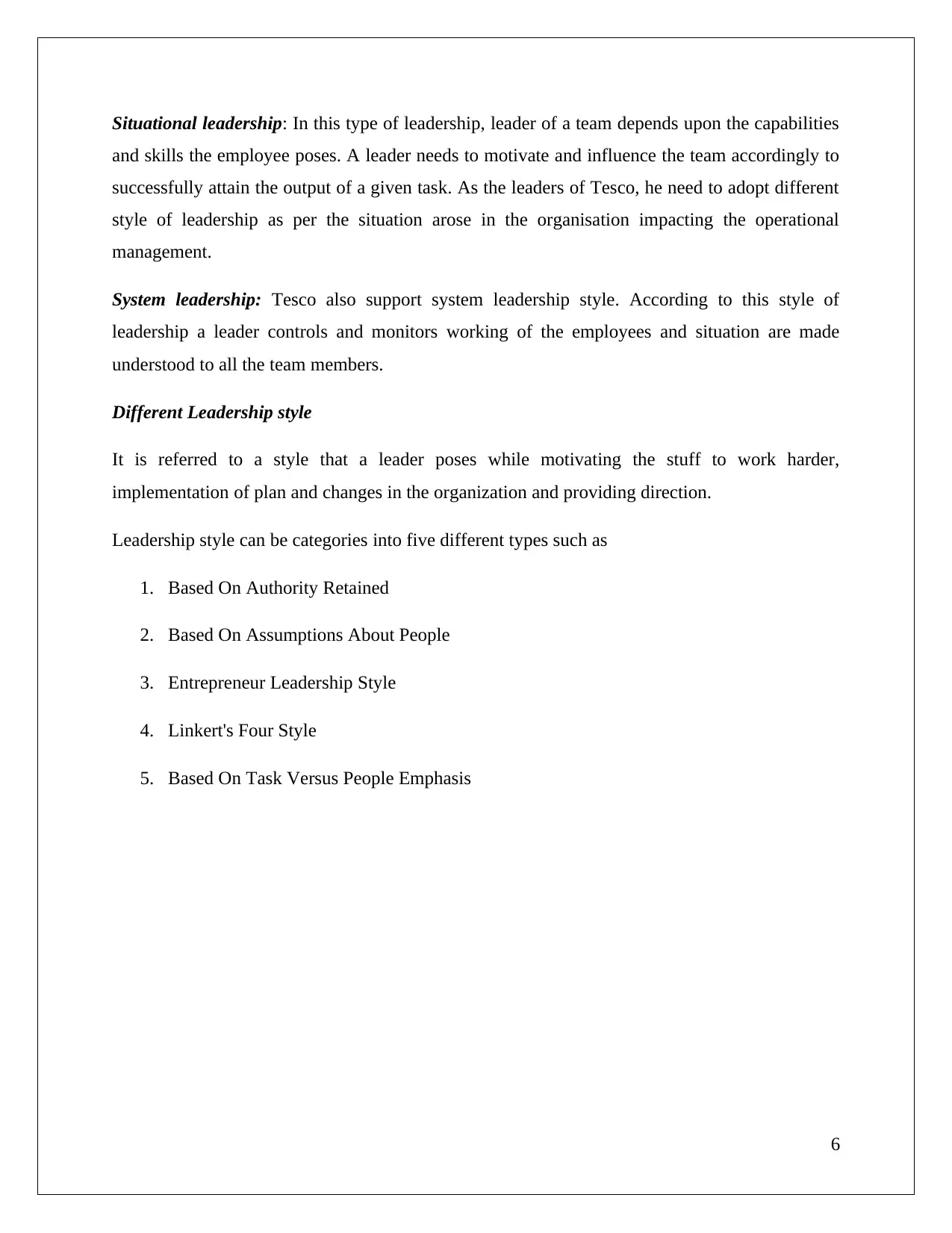
Situational leadership: In this type of leadership, leader of a team depends upon the capabilities
and skills the employee poses. A leader needs to motivate and influence the team accordingly to
successfully attain the output of a given task. As the leaders of Tesco, he need to adopt different
style of leadership as per the situation arose in the organisation impacting the operational
management.
System leadership: Tesco also support system leadership style. According to this style of
leadership a leader controls and monitors working of the employees and situation are made
understood to all the team members.
Different Leadership style
It is referred to a style that a leader poses while motivating the stuff to work harder,
implementation of plan and changes in the organization and providing direction.
Leadership style can be categories into five different types such as
1. Based On Authority Retained
2. Based On Assumptions About People
3. Entrepreneur Leadership Style
4. Linkert's Four Style
5. Based On Task Versus People Emphasis
6
and skills the employee poses. A leader needs to motivate and influence the team accordingly to
successfully attain the output of a given task. As the leaders of Tesco, he need to adopt different
style of leadership as per the situation arose in the organisation impacting the operational
management.
System leadership: Tesco also support system leadership style. According to this style of
leadership a leader controls and monitors working of the employees and situation are made
understood to all the team members.
Different Leadership style
It is referred to a style that a leader poses while motivating the stuff to work harder,
implementation of plan and changes in the organization and providing direction.
Leadership style can be categories into five different types such as
1. Based On Authority Retained
2. Based On Assumptions About People
3. Entrepreneur Leadership Style
4. Linkert's Four Style
5. Based On Task Versus People Emphasis
6
Paraphrase This Document
Need a fresh take? Get an instant paraphrase of this document with our AI Paraphraser
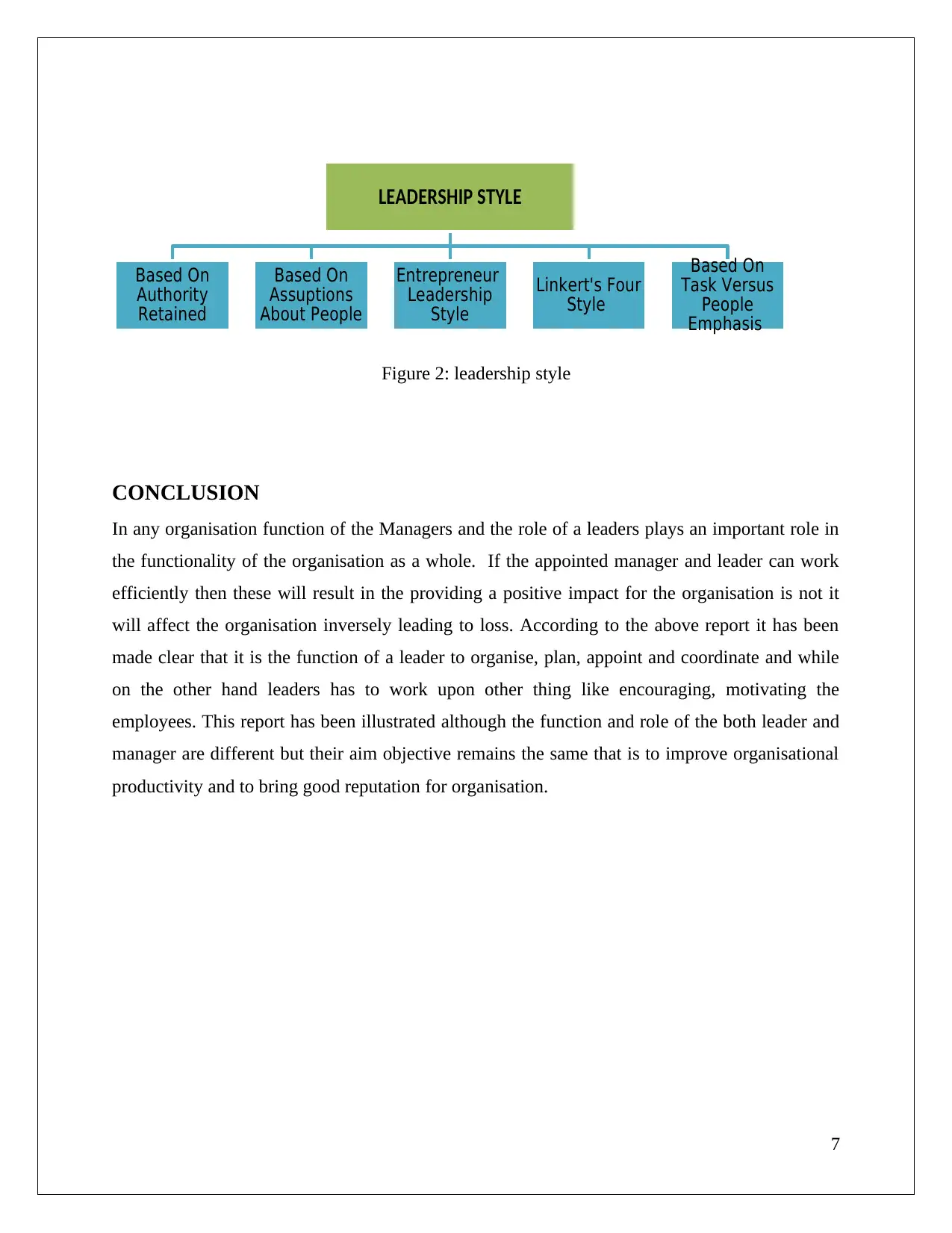
Figure 2: leadership style
CONCLUSION
In any organisation function of the Managers and the role of a leaders plays an important role in
the functionality of the organisation as a whole. If the appointed manager and leader can work
efficiently then these will result in the providing a positive impact for the organisation is not it
will affect the organisation inversely leading to loss. According to the above report it has been
made clear that it is the function of a leader to organise, plan, appoint and coordinate and while
on the other hand leaders has to work upon other thing like encouraging, motivating the
employees. This report has been illustrated although the function and role of the both leader and
manager are different but their aim objective remains the same that is to improve organisational
productivity and to bring good reputation for organisation.
7
LEADERSHIP STYLE
Based On
Authority
Retained
Based On
Assuptions
About People
Entrepreneur
Leadership
Style
Linkert's Four
Style
Based On
Task Versus
People
Emphasis
CONCLUSION
In any organisation function of the Managers and the role of a leaders plays an important role in
the functionality of the organisation as a whole. If the appointed manager and leader can work
efficiently then these will result in the providing a positive impact for the organisation is not it
will affect the organisation inversely leading to loss. According to the above report it has been
made clear that it is the function of a leader to organise, plan, appoint and coordinate and while
on the other hand leaders has to work upon other thing like encouraging, motivating the
employees. This report has been illustrated although the function and role of the both leader and
manager are different but their aim objective remains the same that is to improve organisational
productivity and to bring good reputation for organisation.
7
LEADERSHIP STYLE
Based On
Authority
Retained
Based On
Assuptions
About People
Entrepreneur
Leadership
Style
Linkert's Four
Style
Based On
Task Versus
People
Emphasis
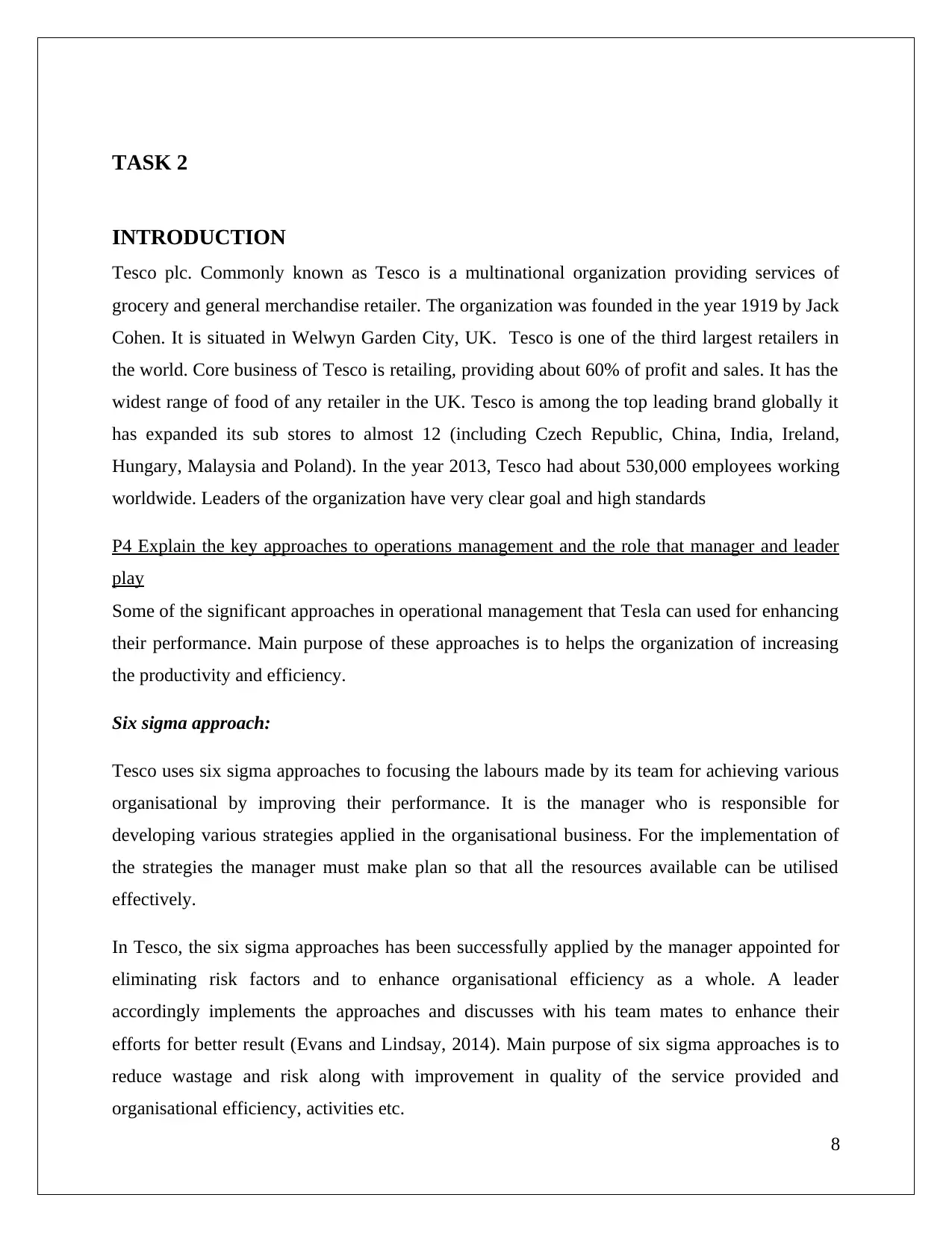
TASK 2
INTRODUCTION
Tesco plc. Commonly known as Tesco is a multinational organization providing services of
grocery and general merchandise retailer. The organization was founded in the year 1919 by Jack
Cohen. It is situated in Welwyn Garden City, UK. Tesco is one of the third largest retailers in
the world. Core business of Tesco is retailing, providing about 60% of profit and sales. It has the
widest range of food of any retailer in the UK. Tesco is among the top leading brand globally it
has expanded its sub stores to almost 12 (including Czech Republic, China, India, Ireland,
Hungary, Malaysia and Poland). In the year 2013, Tesco had about 530,000 employees working
worldwide. Leaders of the organization have very clear goal and high standards
P4 Explain the key approaches to operations management and the role that manager and leader
play
Some of the significant approaches in operational management that Tesla can used for enhancing
their performance. Main purpose of these approaches is to helps the organization of increasing
the productivity and efficiency.
Six sigma approach:
Tesco uses six sigma approaches to focusing the labours made by its team for achieving various
organisational by improving their performance. It is the manager who is responsible for
developing various strategies applied in the organisational business. For the implementation of
the strategies the manager must make plan so that all the resources available can be utilised
effectively.
In Tesco, the six sigma approaches has been successfully applied by the manager appointed for
eliminating risk factors and to enhance organisational efficiency as a whole. A leader
accordingly implements the approaches and discusses with his team mates to enhance their
efforts for better result (Evans and Lindsay, 2014). Main purpose of six sigma approaches is to
reduce wastage and risk along with improvement in quality of the service provided and
organisational efficiency, activities etc.
8
INTRODUCTION
Tesco plc. Commonly known as Tesco is a multinational organization providing services of
grocery and general merchandise retailer. The organization was founded in the year 1919 by Jack
Cohen. It is situated in Welwyn Garden City, UK. Tesco is one of the third largest retailers in
the world. Core business of Tesco is retailing, providing about 60% of profit and sales. It has the
widest range of food of any retailer in the UK. Tesco is among the top leading brand globally it
has expanded its sub stores to almost 12 (including Czech Republic, China, India, Ireland,
Hungary, Malaysia and Poland). In the year 2013, Tesco had about 530,000 employees working
worldwide. Leaders of the organization have very clear goal and high standards
P4 Explain the key approaches to operations management and the role that manager and leader
play
Some of the significant approaches in operational management that Tesla can used for enhancing
their performance. Main purpose of these approaches is to helps the organization of increasing
the productivity and efficiency.
Six sigma approach:
Tesco uses six sigma approaches to focusing the labours made by its team for achieving various
organisational by improving their performance. It is the manager who is responsible for
developing various strategies applied in the organisational business. For the implementation of
the strategies the manager must make plan so that all the resources available can be utilised
effectively.
In Tesco, the six sigma approaches has been successfully applied by the manager appointed for
eliminating risk factors and to enhance organisational efficiency as a whole. A leader
accordingly implements the approaches and discusses with his team mates to enhance their
efforts for better result (Evans and Lindsay, 2014). Main purpose of six sigma approaches is to
reduce wastage and risk along with improvement in quality of the service provided and
organisational efficiency, activities etc.
8
⊘ This is a preview!⊘
Do you want full access?
Subscribe today to unlock all pages.

Trusted by 1+ million students worldwide
1 out of 19
Related Documents
Your All-in-One AI-Powered Toolkit for Academic Success.
+13062052269
info@desklib.com
Available 24*7 on WhatsApp / Email
![[object Object]](/_next/static/media/star-bottom.7253800d.svg)
Unlock your academic potential
Copyright © 2020–2025 A2Z Services. All Rights Reserved. Developed and managed by ZUCOL.



